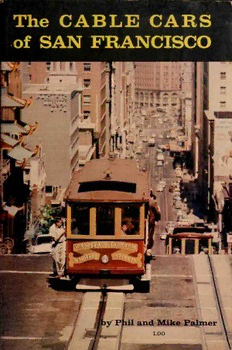
The Cable Cars of San Francisco PDF
Preview The Cable Cars of San Francisco
CABLE CARS The SAN FRANCISCO of Mike Palmer California Street car, right, at top of Nob Hill; Bay Bridge tower in background published by HOWELL-NORTH 1050 PARKER STREET BERKELEY 10, CALIFORNIA Second edition, 1963 Copyright 1959 by Howell-North Books The Cable Cars OF SAN FRANCISCO Photographs by Phil Palmer Text by Mike Palmer HOWELL-NORTH No one who has ever ridden on a San Francisco cable car will ever forget the experience. The freewheeling downhill roller coaster rides, the wild rushes through intersections, the apparently hopeless forays into avalanches of autos, the people who hang onto the outside poles and lean into the street on the curves, the conductors who must remember who paid his fare and who didn't, the gripmen who sweat and strain but who really enjoy it, all belong to the cable car, and to the cable car alone. The cars have died out slowly since their peak at the turn of the century. The green cars of Powell Street and the red cars of California are all that remain from the glory days before the firequake of 1906. Yet the surprising thing is that any cable cars are left at all. San Francisco has hung on to these last pieces of nos- talgia not merely as an oddity to attract tourists (they are that), but also as a part of the peculiar charm of living on the Bay. San Francisco is a romantic city—steeped and sim- mered in the indelible tradition of comparatively easy living. The city is up with the times, without a doubt, but it treats the times differently than do most cities. The cable car can't keep up with the powerful electric busses which hiss up the city's steepest hills with effort- less ease, or even the modern automobile, yet it is still part of the lifeblood of countless thousands who live in and around the Golden Gate. In its unhurried, wandering crawl from one point to another, it seems to refute the mad pace of modern living. Illl x 1 OWELL#~1 502 IARKET | il*feS 3BLOCKS :0HTERMINAL I LuncheonDinner BAY* ST.FRANCIS "AYXoml1 Powell Street cable cars Some people, among them certain of the city's most influential leaders in years past, have tried to banish the cable car into the land of the five cent beer and steam locomotive. Partly out of economic necessity the cable lines have been trimmed down. Partly out of pure stubborness some of the harm- less lines have been erased, replaced by streetcars and busses. The anti-cable car faction won part of its battle, but the pro-car forces won a moral victory in saving two lines. The cable car still lives, and although it will vanish someday, the persons who rip out the last narrow gauge tracks will have had a bitter fight with those who love San Francisco and who know the spirit of the Golden Gate City. m T«l *»' 1 iM I r ' ] ii i v M i m sa i J i* - sft A California Street car passes Old St. Mary's Church The Powell-Hyde car, right, is nearly always crowded by the time it reaches Nob Hill. During the summer, riders on the Hyde Street car can watch the fog blowing over the Marin County hills across the Bay, below. '^m^^i A conductor pushes car onto tracks at Hyde-Beach turntable SOME CABLE CAR HISTORY On a winter night in 1869, an overloaded horsecar started up one of the city's steep hills which had been slickened by rain and fog. Halfway up, goes the story, one of the four horses towing the car slipped. The car started to roll backwards; the brake snapped and the horses were dragged down to the bottom of the grade. Luckily, none of the passengers was injured, but the horses had to be destroyed. A horrified witness to the accident was a young man of 33, Andrew Hallidie, who was born in England but had been a resi- dent of California since 1852. Hallidie was fairly well known in commercial circles in 1869 as the owner of a wire rope manufacturing company that turned out good quality products. Hallidie, like his father before him, was fond of inventing. Among his patents was one he took out in 1867 for a wire rope suspension bridge. But his most remembered inven- tion was the cable car. Hallidie had had some earlier success with mining transporta- tion systems in the Mother Lode gold rush country. He had run cars from one peak to another over deep valleys, with the vehicles suspended from a slender but strong cable. With the thought of San Francisco's horsecar accidents in mind, but perhaps with visions of financial return prodding him along, too, Hallidie set out to devise a cable car system for the city. He took two years to complete the first plans and was ready in 1871 to build a working model. He obtained a franchise from the city with the proviso that all rights would be forfeited if the line was not ready by August 1, 1873.
